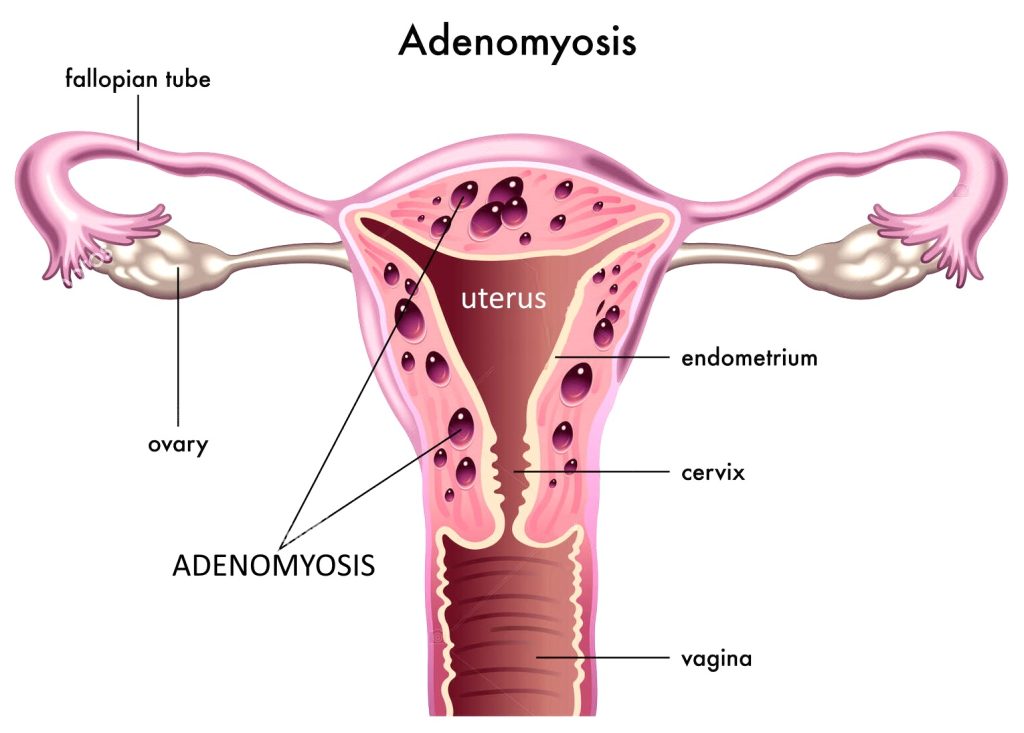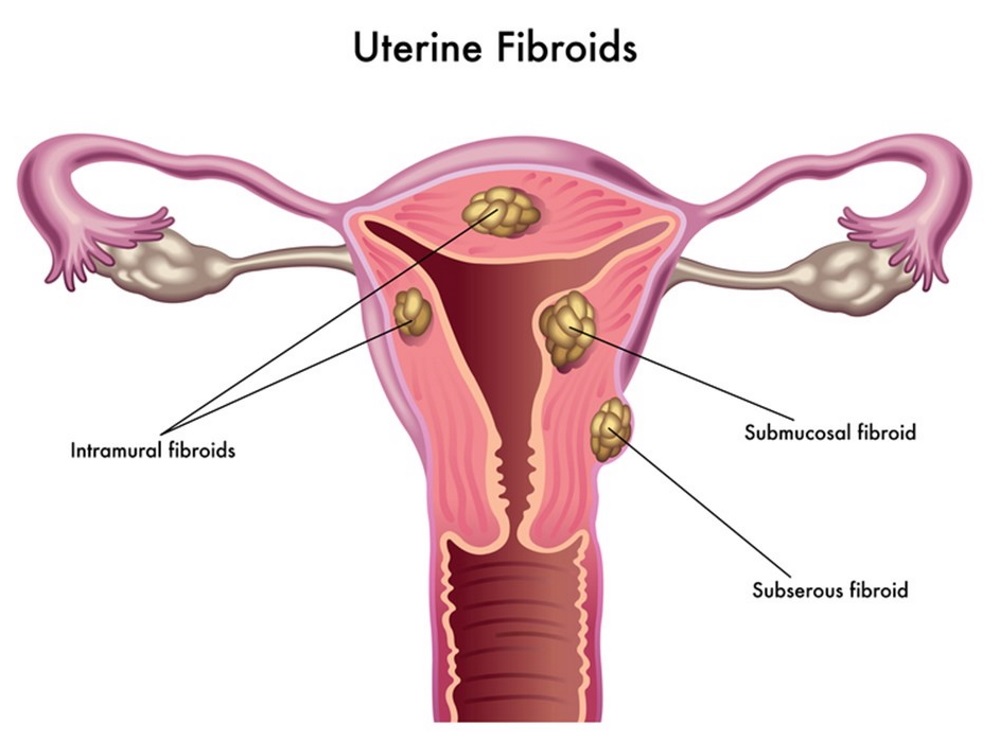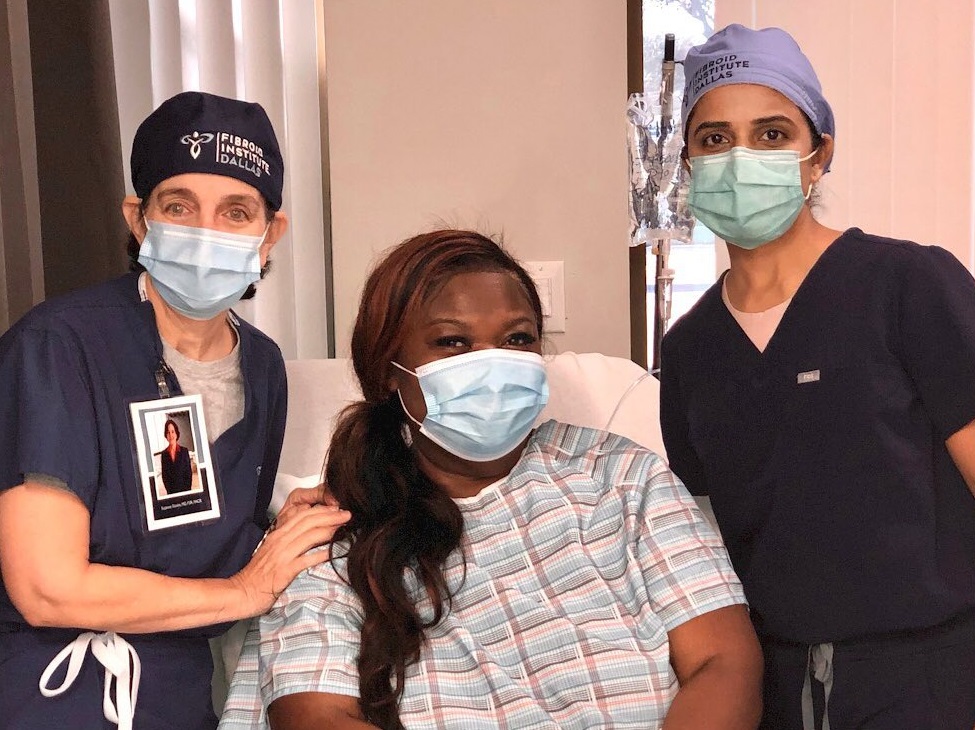Becky had been suffering from severe cramping and heavy menstrual bleeding for months—even between regular periods. She best described the feeling as if someone were stabbing her pelvis with a sharp knife. After some quick online research, she was convinced that uterine fibroids were the culprit before she even showed up for her first doctor’s appointment. After a few exams, her gynecologist confirmed that the pain she was experiencing was actually because of another uterine disorder called adenomyosis. Both adenomyosis and fibroids present similar symptoms, often leading to one being misdiagnosed for the other.
While similar in the sense that they both impact the uterus and can be rather uncomfortable for some women, it is important to note that adenomyosis and fibroids are not the same, nor are their symptoms 100% identical. Also, the symptoms one woman faces may not be the same as another. In some cases, women don’t experience any pain. This is why a proper diagnosis is critical to pursuing the best treatment option for your unique situation.
Adenomyosis and Fibroids: Similar Symptoms, Different Conditions
Adenomyosis is a benign disease of the female reproductive system where endometrium (tissue that normally lines the uterus) also grows inside the muscular walls of the uterus (myometrium). As a result, your uterus will thicken and may double or triple its normal size. There is no known cause for this condition, and its prevalence varies, with one study suggesting that it impacts 12% to 58% of females. But it is more common in women between the ages of 40 and 50 years old who have had at least one pregnancy and have been diagnosed with endometriosis or fibroids.
Brigham and Women’s Hospital says more than 80% of women with adenomyosis have another abnormal condition in the uterus; 50% of patients have adenomyosis and fibroids, 11% have endometriosis, and 7% have endometrial polyps. As a result, the shared symptoms make it difficult to diagnose adenomyosis.

Common adenomyosis symptoms include:
- Heavy or prolonged menstrual bleeding
- Severe cramping or sharp, knife-like pelvic pain during menstruation
- Longer than usual menstrual cramps
- Leg pain
- Enlarged uterus
- Pain during intercourse
- Bloating
- Bleeding between periods
- Passing blood clots during a period
- Lower abdominal pressure
The main difference between adenomyosis and fibroids is that fibroids are non-cancerous growths that develop from the muscle tissue of the uterus. While adenomyosis and fibroids can both be painless, fibroids are more common, with the majority of women diagnosed in between the ages of 35 and 54. Women younger than 35 and older than 54 can have fibroids, too. Depending on your situation, you may have one or several fibroids. In addition, they could all differ in size and either stay that way or grow at different rates.

The growth factor is of particular concern to women since uterine fibroids can continue to grow, becoming large and uncomfortable.
Common fibroid symptoms include:
- Painful periods, including heavy or inconsistent cycles
- Debilitating cramps, pelvic pain, and pressure
- Back or leg pain
- Bloating or swelling in the lower abdomen
- Back or leg pain
- Weight gain
- Pain during sexual intercourse
- Urinary frequency
- Constipation, diarrhea, and rectum discomfort
- Fatigue and weakness
As you can see, adenomyosis and fibroids symptoms are similar in that leg pain, blood clots, and prolonged menstrual bleeding are typical signs of adenomyosis. Urination issues, weight gain, and fatigue are common with fibroids.
How Are Adenomyosis and Fibroids Diagnosed and Treated?
There are a few surefire tests that can be done if you or your doctor suspect that you have adenomyosis or fibroids, or both. Taking account of the symptoms you’re experiencing is the first step. Like previously mentioned, while there are similarities in symptoms, adenomyosis and fibroids still have pretty clear disparities. A doctor-performed pelvic examination should also reveal adenomyosis if you have an enlarged uterus that’s tender to the touch. Ultrasound and an MRI of the uterus can also be called on to achieve a proper diagnosis.
While adenomyosis can go away after menopause, the only cure is a hysterectomy, which completely or partially removes the uterus and other reproductive organs. This is a major surgical procedure and will usually require a stay in the hospital with a longer recovery time. If surgery is not an option you wish to consider, or you represent a technically challenging surgical case, uterine fibroid embolization (UFE) is a minimally invasive alternative to complex surgeries that has been proven to reduce fibroid symptoms.

UFE Is an Option for Adenomyosis and Fibroids
Uterine fibroid embolization (UFE) is a unique, low-risk procedure because it treats fibroids without having to go through an invasive surgery and lengthy recovery time. Although not a cure, it is also an acceptable treatment option to reduce painful symptoms of adenomyosis. With UFE, small particles are injected through a tiny catheter at the wrist using image-guided interventional radiology. With fibroids, these particles are introduced through the uterine arteries into the fibroid vessels, blocking the blood flow to the fibroids. By cutting off blood flow to all fibroids, the fibroids shrink and die so that you can get back to your lifestyle and normal activities quickly. Conversely, the UFE procedure blocks blood to the adenomyosis tissue relieving adenomyosis symptoms 75% of the time.
Advantages of UFE at Fibroid Institute include:
- In-office procedure instead of hospital stay
- Tiny wrist puncture, no need for vaginal access
- Recovery time only 7-10 days versus 4-6 weeks for surgery
- >90% reduction of fibroid-related symptoms
- Fibroid symptoms improve dramatically
- Procedure typically takes less than an hour
- All fibroids may be treated at the same time
- Avoids side effects of pharmaceutical therapies typically used to treat fibroids
Knowing everything you possibly can about adenomyosis and fibroids and having regular screenings will help you and your doctor determine the right course of action and avoid potential complications in the future.
Improve Adenomyosis and Fibroid Pain at Fibroid Institute
Fibroid Institute is the go-to source for educating patients about uterine fibroids and minimally invasive procedures such as UFE. Our specialists at Fibroid Institute are the fibroid experts you need in your corner.
Request a free 10-15 minute phone screening to determine if you are eligible. After the screening, if you qualify for UFE, you can schedule your onsite or telehealth consultation. Most major medical insurance providers cover the cost of UFE.
At Fibroid Institute Dallas and Fibroid Institute Houston, we are dedicated to helping you become #FibroidFree. Get started now by completing the form below or by calling our Dallas fibroid clinics at 214-838-6440 or Houston fibroid clinics at 713-903-3733.
"*" indicates required fields
Fibroid Institute Texas serves the Dallas and Houston areas including Addison, Carrollton, Plano, Frisco, McKinney, Allen, Fort Worth, Grand Prairie, HEB, Arlington, Hutchins, Irving, Duncanville, DeSoto, Cedar Hill, Lancaster, Cockrell Hill, Highland Park, University Park, Park Cities, Garland, Mesquite, Richardson, Dallas, Sherman, Houston, Sugar Land, Katy, Webster, Clear Lake, The Woodlands, Universal City, Spring, Kingwood, Stafford, Conroe, Texas City, Cypress, League City, Bellaire, and more.
Prior to starting any new treatment or if you have questions regarding a medical condition, always seek the advice of your doctor or other qualified health provider. This information is not a substitute for professional medical advice.

